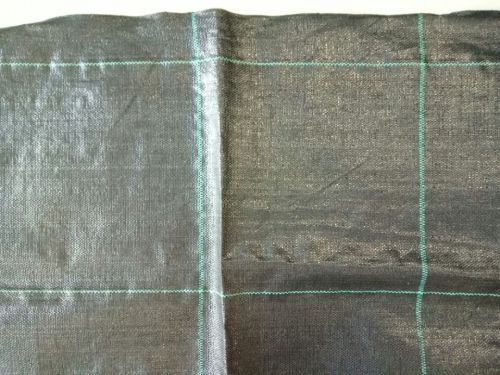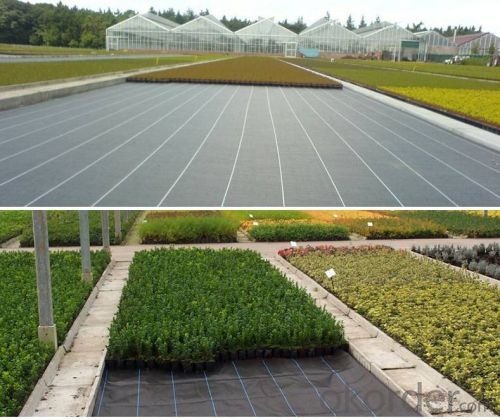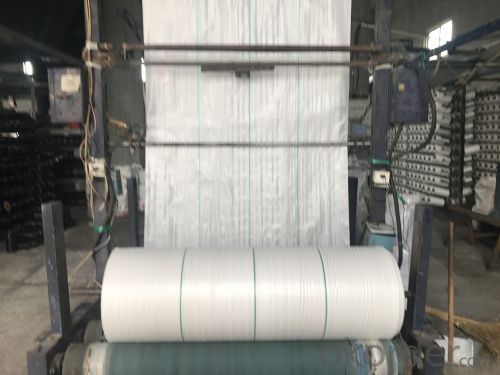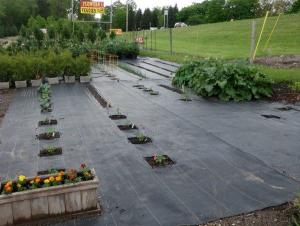Polypropylene Weed Barrier Fabric for Agriculture
- Loading Port:
- Qingdao
- Payment Terms:
- TT or LC
- Min Order Qty:
- 5000 m²
- Supply Capability:
- 100000 m²/month
OKorder Service Pledge
OKorder Financial Service
You Might Also Like
Item specifice
1.Products description:
The weed barrier fabric is a kind of vertical and horizontal weaving plastic woven cloth. It has good quality of permeability,
water seepage and Prevention and control of weeds. Widely used in gardening and agriculture.

2.Products functions and features:
1)Excellent weed control
2)Excellent UV resistance
3)Moisture,fertilizers,air reach plants to allow for healthy soil
4)Good water and air permeability
5)Exceptional toughness and strength
6)Durable,tear-resistant,anti-rot and anti-mildew
7)Light weight,easy to install,follows natural ground contours
8)Ideal for use in landscaped beds,under decks and walkways
9)Fashionable design,high quality,competitive price
10)Long service life

3. Usage:
1.Prevent leakage disposal in landfill or waste water or waste dregs disposing field.
2.River bank ,lake dam ,mine remainings ,resevoir ,tunnel ,liquid storage pool(pit ,mine)
3.Preventing leakage in subway ,basement ,tunnel ,hole .
4.Anti-salt leakage in roadbed and other ground sill.
5.The plane direction laying of dam ,the vertical direction laying for ground sill.used in the construction fence and waste material field.
6.Used in ground sill of road ,highway ,railway and waterproof layer of welling clay and wet collapsed loess.
7.Preventing leakage on rooftop.

4. FAQ:
Q1: What is your minimum order quantity?
A:The minimum order quantity is 5000 ,but it is negotiable.
Q2:What is your payment terms?
A: T/T,Western Union,Paypal,L/C...
Q3:What is your delivery time?
A:Production time usually costs 2-20 days.
Waiting to cooperate with you!
- Q:There are engineering budgets
- Geotextile to polypropylene or polyester and other chemical fiber made of raw materials, to acid and alkali, no corrosion, no moth, anti-oxidation. It is widely used in the field of civil engineering, its main application areas are: 1. Highway, railway, airport, building and other engineering foundation reinforcement treatment; use of geotextile to enhance the soil tensile strength and resistance to deformation, Concentrate the stress spread, transfer or decomposition, to prevent the soil by external force and damage. Enhance the stability of the building structure to improve soil quality. 2. dam and other slope protection project; the use of geotextile good permeability and water permeability, so that water flow through, and thus effectively cut off the loss of sand. Geotextile mesh should not be blocked - due to the formation of amorphous fibrous tissue structure and strain and mobility. Has a good conductivity of water, it can make the formation of drainage within the soil channel, the soil structure of excess liquid and gas exclusion. 3 .. road maintenance works; the use of geotextile isolation characteristics to prevent the upper and lower gravel, soil and concrete mixed between. If you really have the confidence to do sales I can try to support the specific telephone consultation Yinjing Li
- Q:How are geotextiles secured in place?
- Geotextiles are typically secured in place using various methods such as anchoring pins, stakes, or other mechanical devices that are driven into the ground. Additionally, they can also be secured using soil cover, rocks, or other heavy materials to prevent them from shifting or moving.
- Q:Can geotextiles be used for reinforcement in asphalt overlays?
- Yes, geotextiles can be used for reinforcement in asphalt overlays. Geotextiles are commonly used to improve the performance and longevity of asphalt overlays by providing reinforcement and mitigating cracking. They help distribute the load and stresses, reduce reflective cracking, and improve the overall structural integrity of the pavement.
- Q:What are the factors to consider when specifying geotextiles?
- When specifying geotextiles, there are several factors that need to be considered. These include the intended application, site conditions, required strength and durability, permeability requirements, installation and maintenance considerations, and cost-effectiveness. It is important to carefully evaluate these factors to ensure the geotextile selected will meet the specific needs of the project and provide the desired performance and longevity.
- Q:How do geotextiles contribute to the stability of landfill slopes?
- Geotextiles contribute to the stability of landfill slopes by providing reinforcement and erosion control. They are placed between different layers of soil to enhance the overall strength and stability of the slope. Geotextiles help to distribute the loads more evenly, preventing excessive settlement and potential slope failure. Additionally, they reduce soil erosion by acting as a barrier against water flow, thus protecting the slope from erosion and maintaining its stability over time.
- Q:What are the environmental impacts of geotextile production?
- The environmental impacts of geotextile production primarily include energy consumption, greenhouse gas emissions, and waste generation. The production process requires significant amounts of energy, mainly derived from fossil fuels, leading to carbon dioxide emissions and contributing to climate change. Additionally, the extraction and processing of raw materials for geotextiles can result in habitat destruction and soil degradation. Furthermore, the production process generates waste, such as wastewater, air emissions, and solid waste, which can have adverse effects on local ecosystems if not properly managed.
- Q:What are the types of geotextiles used in railway subgrade
- Railway is more demanding than the highway, the railway subgrade is to bear and pass the orbital gravity and the dynamic structure of the train structure, is the basis of the track is to ensure that the train running an important building, the roadbed is a rock and soil structure, in a variety of topography, Geological and climatic conditions, such as floods, debris flow, earthquakes and so on. Therefore, geotextile in which the main play of his reinforcement and isolation, reinforcing the main material to enhance the shear and tensile deformation of the ability to prevent reflection of cracks in the road; isolation is the separation of different materials to maintain their own performance. As the geotextile itself is not waterproof, in the old road renovation over the asphalt mixture will form impermeable complex, in addition to preventing cracks and a certain degree of water defense, the railway subgrade is usually used in the two cloth a film complex Published, so with 600 grams of filament geomembrane more
- Q:What are the limitations of using geotextiles?
- Some limitations of using geotextiles include their susceptibility to clogging, reduced effectiveness in high-flow conditions, potential for damage during installation or handling, limited ability to withstand heavy loads, and relatively short lifespan compared to other geosynthetic materials. Additionally, geotextiles may not be suitable for all soil types or environmental conditions, and their performance can vary depending on factors such as installation technique and maintenance.
- Q:Why do you want to set up geotextiles around the bottom and bottom of the ditch? What role? Which predecessors help me explain.
- Why do you want to set up geotextiles around the bottom and bottom of the ditch? What role? Which predecessors help me explain.
- Q:What are the specifications for geotextiles used in erosion control mats?
- The specifications for geotextiles used in erosion control mats typically include factors such as the material composition, weight, tensile strength, permeability, and UV resistance. These geotextiles are designed to provide effective erosion control by stabilizing soil, preventing sediment runoff, and promoting vegetation growth.
1. Manufacturer Overview |
|
|---|---|
| Location | |
| Year Established | |
| Annual Output Value | |
| Main Markets | |
| Company Certifications | |
2. Manufacturer Certificates |
|
|---|---|
| a) Certification Name | |
| Range | |
| Reference | |
| Validity Period | |
3. Manufacturer Capability |
|
|---|---|
| a)Trade Capacity | |
| Nearest Port | |
| Export Percentage | |
| No.of Employees in Trade Department | |
| Language Spoken: | |
| b)Factory Information | |
| Factory Size: | |
| No. of Production Lines | |
| Contract Manufacturing | |
| Product Price Range | |
Send your message to us
Polypropylene Weed Barrier Fabric for Agriculture
- Loading Port:
- Qingdao
- Payment Terms:
- TT or LC
- Min Order Qty:
- 5000 m²
- Supply Capability:
- 100000 m²/month
OKorder Service Pledge
OKorder Financial Service
Similar products
New products
Hot products
Related keywords

































